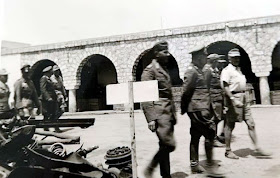British Field Marshal Sir Cyril Deverell, Chief of the Imperial General Staff, inspects a Luftwaffe honor guard in September 1937. The German Generalleutnant right behind him is Walther von Reichenau.
von Reichenau was born in 1884, joined the army in 1902, and served in the First World War. After the war, he continued his military career. When he was introduced to Hitler by an uncle in 1932, he became a loyal follower and joined the NSDAP (Nazi Party), despite army regulations that were there to keep the army and politics separate. Apart from furthering his career, he opposed the radical SA (Sturmabteilung) leader Ernst Röhm, who had pressed for SA to become the major military force in the new Reich. Conspiring with Himmler and Göring, he was one of the instigators of “the Night of the Long Knives” in 1934, where Röhm and other leaders of the SA were purged and executed.
In 1938 Adolf Hitler wanted to appoint him as Commander-in-Chief of the Army. Leading figures in the German Army complained and Gerd von Rundstedt, Franz Halder and Ludwig Beck all refused to serve under him. The job went to Friedrich von Brauchitsch instead. von Reichenau led armies in both the invasion of Poland and of France, and was promoted to Generalfeldmarschall in 1940. One would think that such an ardent Nazi and career officer would favor the plans for an attack on the Soviet Union in 1941, but von Reichenau actually opposed them. This didn’t stop him from being appointed to lead the 6th Army.
Once committed to the war in the East, he led the 6th Army in capturing Kiev, Belgorod, Kharkov and Kursk. An anti-semite, Reichenau encouraged his soldiers to commit atrocities against the Jews in the territory under his control (the “Reichenau Order”). On one occasion he told his men: “In this eastern theatre, the soldier is not only a man fighting in accordance with the rules of the art of war… For this reason the soldier must learn fully to appreciate the necessity for the severe but just retribution that must be meted out to the subhuman species of Jewry…” All Jews were henceforth to be treated as de facto partisans, and commanders were directed that they be either summarily shot or handed over to the Einsatzgruppen execution squads.
In other matters, he displayed some sound thinking, like recognizing the Soviet superiority in armor and the risks attached to it, the need for recruiting Ukrainians and Byelorussians to fight the Red Army alongside the Wehrmacht, and the risk of increasing partisan warfare. Reichenau used to go on a daily cross-country run in order to keep fit. On 12 January, 1942, he ran several kilometers in temperatures well below -20 degrees Celcius. When he returned, he had a severe heart attack (some sources say that it was a stroke). After being unconscious for five days, it was decided to fly him back to Germany. Walter von Reichenau died on 17 January 1942, when the plane carrying him to Leipzig crash-landed and he reportedly suffered a fatal heart attack. His funeral was performed with the usual pomp of the Third Reich. Hitler did not attend his funeral.
He was succeeded by General Friedrich Paulus, who took command of the 6th Army. Paulus was a staff officer who had never led a unit larger than a battalion. A year later, he surrendered to the Soviets in the ruins of Stalingrad, his army in tatters. What would have happened if von Reichenau, a much more competent and decisive officer, hadn’t died? One thing is pretty sure, though: if he had survived to the end of the war, he would’ve been one of the generals on trial in Nürnberg, and would probably have ended up in the gallows as a war criminal.
Source :
Björn Hellqvist photo collection
https://ww2inphotos.wordpress.com/2017/07/page/1/











































